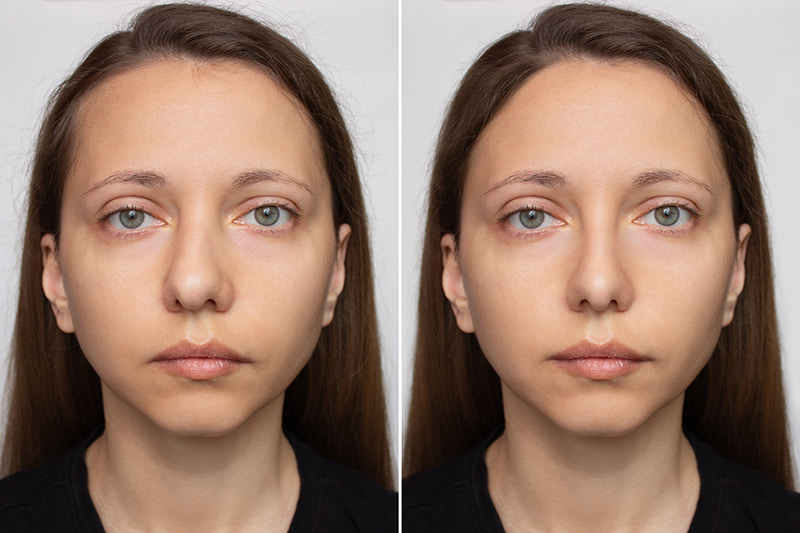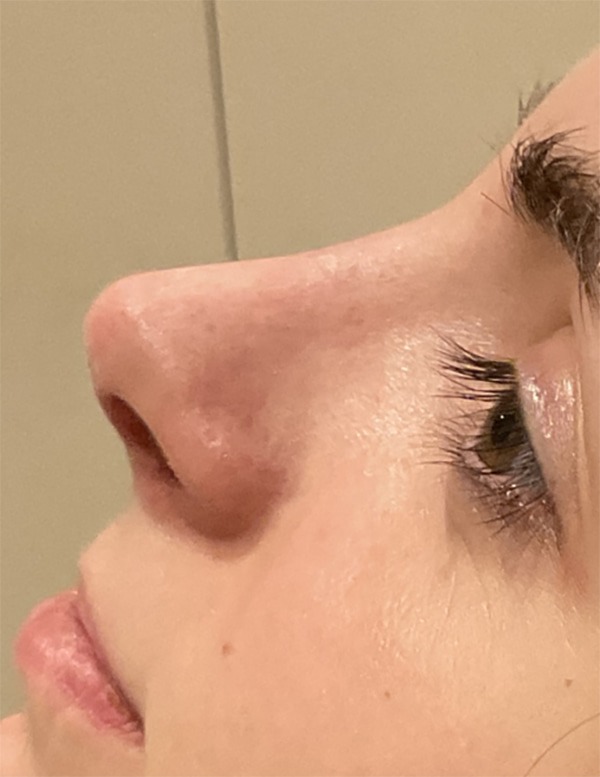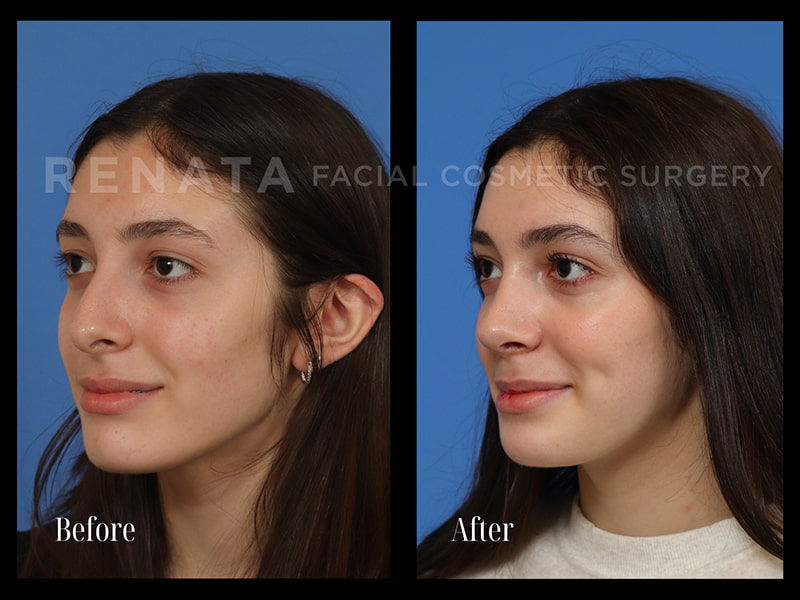



The noses I see on social media today are starting to take on a very similar look — overly narrow bridges, pointed and upturned tips, and sharp, contrasting angles. I am not sure if this is what patients are collectively asking for, or what surgeons are collectively promoting. The truth probably lies somewhere in between. When a patient comes to see me for a rhinoplasty consultation, I try to begin with as blank a canvas as possible.
There was a time when the operation was defined by subtraction. Cartilage was trimmed aggressively, bridges were lowered too far, and tips were pinched until the structure gave way. Some patients could not breathe well afterward. Others looked fine in photographs for a year or two, only to watch their noses slowly collapse inward as scar tissue took over. That era taught me the most important lesson in nasal surgery: form and function are inseparable. Undermine one, and the other will inevitably follow.

This model patient depiction illustrates how nasal form and function are deeply connected. We expect noses that look good to work well, too. On the left, the nasal crookedness may appear primarily cosmetic, but functionally, it can block airflow on one or both sides. Correction requires straightening the structure—not just a septoplasty alone—to restore balance and breathing. In doing so, the aesthetic form naturally improves, often with additional refinements performed simultaneously for a harmonious result.
Today I build first and refine second. The framework of the nose is based entirely on architecture. If I remove too much cartilage, I take away the very scaffolding that holds its shape and keeps the airway open. The challenge, therefore, becomes creating shape while maintaining strength. In fact, a stronger nose usually looks better too, because it holds its contour in motion and over time.
Where does this strength come from? Support often comes from “grafts.” Grafts are pieces of cartilage that can be taken from a patient’s own body or from a banked human source. Autologous, meaning one’s own, septal cartilage is my first choice when available because it is straight, rigid, and already part of the nasal surgery. When the septum has been removed previously, such as in a functional septoplasty, or is found to be insufficient at the time of surgery, I may use ear cartilage instead. When the treatment plan requires significant grafting, additional support, or revision nasal surgery, rib cartilage becomes the best choice. Rib cartilage is strong, thick, and allows for the greatest amount of structural grafting to reconstruct a severely weakened nose.
Once we have a source of cartilage available for the surgery, we then decide on the shape and placement of these grafts. Often, this becomes clear after clinical evaluation. A pinched nasal tip will require long, straight, and strong grafts along the walls of the nostrils. A crooked or pinched bridge will require long, straight grafts along the septum, called spreader grafts. These grafts, while straightening and shaping the nose, also dramatically improve its function.
Once again, we see how the form of the nose that we desire works hand in hand with the function of the nose that we depend on. While grafts are vital to any rhinoplasty, even a first time surgery, they are meant to be subtle moves that do not advertise themselves. No one should ever see a graft. If they do, it was not done correctly. Grafts should blend seamlessly with the surrounding structures and contribute quietly to the overall silhouette.
Aesthetic improvement that compromises breathing is not success. There are several parts of the nose that are purely functional, and in fact, many of them you cannot even see directly. For example, the internal nasal valve is a space that can be either narrow or wide, and its shape is determined by the angle between the nasal sidewall and the septum. We assess this carefully during every nasal evaluation.
Why do I discuss this with patients? Imagine someone who has chronic difficulty breathing but also desires an overly thin, knife-edge bridge as part of the overall look. If the surgery does not widen their internal nasal valve to improve their breathing, which will have the effect of making the bridge a bit wider and softer, it may actually collapse when narrowed further during inhalation. This would worsen breathing beyond the original problem. A softened, widened bridge is actually a highly pleasing feature when planned correctly with the right type of nasal tip.
In every case, I address both nasal function and appearance during the same operation. Straightening a deviated septum, reinforcing weak valves, and correcting a crooked bridge can and should be planned together. When patients undergo a functional septoplasty as a standalone procedure, they are often asked whether they would ever consider cosmetic changes to their nose. If so, the surgeon may refer them to a plastic surgeon to combine both functional and aesthetic improvements.
That referral is an enormous service to the patient, because a septoplasty alone removes the crooked portion of the septum and discards that vital cartilage. Even though it is crooked, it remains extremely useful for grafting purposes, since only small pieces are needed. We can almost always find straight sections within a previously deviated septum. Therefore, doing a septoplasty gets a surgeon halfway there to a rhinoplasty! I always recommend combining functional and cosmetic goals at the same time by a skilled, capable, and knowledgeable surgeon.

Close-up at just 2 weeks after a complex septorhinoplasty involving both internal and external refinement. This nose demonstrates balanced proportions: a smooth bridge, gentle tip elevation, and no harsh breaks or hooks along the profile. My favorite detail is the base of the nose - a clean, flat bottom contour that eliminates the droopiness so many patients notice. The result is soft, elegant, and most importantly, functional. Structural support was achieved using the patient’s own septal cartilage for the septoplasty, internal valve grafts, and multiple tip grafts.
A very well known surgeon once told me - “Everyone wants a natural result until they get a natural result.” Proceed with caution. Natural does not mean invisible. Rarely have I had a patient go to the operating room and barely anything has changed externally. Natural, to me, means correct and proportional for the face – with some added personal flair, when applicable. For some patients, that involves smoothing a pronounced dorsal hump, refining a bulbous tip, or straightening a crooked nose after injury. For others, it means softer changes because of thicker skin or more delicate issues to begin with.
The skin is a very important factor in predicting the results of nasal surgery because it serves as the “quilt” over the work that we as surgeons do. The thicker the skin ,the thicker the quilt covering the changes in the bone and cartilage, and the harder it is to see finesse changes. The thinner, the easier it is to see those changes. We are unable to guarantee precision to the millimeter because this is not how surgery proceeds or healing progresses. Scar tissue can add 1-2 mm. Skin thickness too. Swelling too. There will always be a small nuance, a small asymmetry, a small deflection. However, a successful result is one that does not fight the face or your attention. A successful result has improved the nose in the desired direction. It blends seamlessly and beautifully, with little dispute.

My actual patient. She is undeniably beautiful on both sides of this photo. Her goal was a subtle reduction in nasal size: nothing dramatic, just refined. She breathed well before and continues to breathe beautifully after surgery. This is a perfect example of how small, thoughtful changes can make a big difference. Even so, her transformation required multiple structural grafts to create a nose that is strong, not weak; supported, not pinched; stable, not temporary. I felt confident this result would stand the test of time. I’ll always remember the joy in that moment when we hugged and celebrated her journey together.
Rhinoplasty touches nearly every discipline of facial surgery. Proportions, bone, cartilage, soft tissue dynamics, scar biology, and airway mechanics. A surgeon who works exclusively on the face and neck lives in these details daily and often has profound training in head and neck trauma that allows for increased understanding of nasal anatomy. As facial surgery experts, we were trained constantly on facial reconstruction techniques in the worst case scenarios - motor vehicle accidents, gunshot wounds, stabbings, burns, sports injuries, interpersonal violence, and even cancer. There are many reasons and situations that trained us to rebuild the nose from dismal starting points, not to mention manage the healing processes and the refinement surgeries that sought additional improvements.
That depth of surgical training becomes important in cosmetic cases, because we are trained to respect anatomy above all, and challenging cases become more routine and predictable in our hands. In revision cases, the understanding of anatomy and structural supports becomes even more paramount. Most surgeons do not pursue revision cases without first mastering the art and science of primary rhinoplasty. To put it lightly - we learn what to do far too soon. It is much later in our careers that we are humbled enough to know what not to do.

A beautiful nose blends quietly, rather than stands out and steals all the attention. This holds true for noses that appear too large or too small. There’s a quiet reality in which a nose and its shape complements the face effortlessly. I believe noses like this will stand the test of time, trends, and personal shifts in style.
The operations I perform now are safer and more predictable because they respect the physiology of the nose alongside cosmetic goals. A patient who has a very exotic cosmetic goal for their rhinoplasty may not understand what they are putting at risk as far as long term breathing function. In my consultation, it is my job to inform them, and decide whether this type of surgery is possible in my hands and ethos. Additionally, the operations I perform today are more predictable because they use support rather than reckless reduction. They are more natural because they start with the face and work backward to the silhouette.
When I perform computer imaging for rhinoplasty, I often look at the chin, lips, and forehead shape to assess what kind of silhouette to plan for and recommend. My patients appreciate when I explain how I got to the computer simulated nose. I do not believe in extremes, but I do believe in a straight or slightly curved bridge, strong sidewalls, open valves, and gorgeous well-defined tips that hold their shape when you smile.
If you are thinking about rhinoplasty, I recommend finding a surgeon who can explain your anatomy and cosmetic options clearly. Ask how the airway will be protected. Ask what will be preserved, not only what will be taken away. Ask how the plan will behave in five years, not just five months. Ask for imaging.
The best noses fit into your everyday life - they breathe well, photograph well, and age well. Unlike lifting surgery that corrects aging and sagging and lasts for a certain amount of time, rhinoplasty is unique. I believe that today’s techniques allow rhinoplasty to be a once-in-a-lifetime procedure. And with the best of intentions, I’ll simply say – choose wisely with a New York facial cosmetic surgeon who values both form and function.
As always – thanks for reading.
xo, Dr. Renata
Medical disclaimer: The results and experiences shared in this blog reflect real patient outcomes from procedures I have personally performed. They are intended for educational and informational purposes only and should not be interpreted as medical advice or a guarantee of results. Cosmetic surgery outcomes vary based on individual anatomy, healing response, and other personal factors. Every surgical procedure is both a science and an art, and results will differ from person to person. For personalized medical guidance, please consult with a qualified and board-certified healthcare provider.
At RENATA Facial Cosmetic Surgery, we prioritize privacy. While many Before & After photos are featured on our website and social media channels, we understand not everyone wishes to share them publicly. To respect our patients’ unique preferences, we invite you to explore a more comprehensive Before & After gallery during your consultation in our office.







Life can be demanding, and we understand. For patients who may be traveling, preparing for a last-minute occasion, or simply looking for a more exclusive experience without any inconvenience or delays, we are pleased to offer preferred patient scheduling. Patients may undergo a personal consultation as well as tailored cosmetic treatments during evening hours or weekends. Appointments are required and premium rates apply. Please call our office to inquire about preferred patient scheduling and allow us to create an exceptional experience just for you.
Request a ConsultationAt RENATA Facial Cosmetic Surgery, patients receive excellent customer service, communication, personal attention, and scheduling flexibility. Located in the historical and breathtaking waterfront neighborhood of DUMBO, Brooklyn in New York City, our office serves local neighborhoods including Brooklyn Heights, Park Slope, Williamsburg, and Cobble Hill, as well as Manhattan and New York City at large.
Our office location is:
58 Prospect Street, Brooklyn, NY 11201